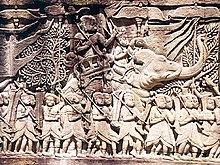| Revision as of 01:14, 6 October 2008 editShogartu (talk | contribs)50 edits '''COPERNICUS is POLISH astronomer'''← Previous edit | Revision as of 01:15, 6 October 2008 edit undoSilly rabbit (talk | contribs)Extended confirmed users18,834 edits Undid revision 243321091 by Shogartu (talk)Next edit → | ||
| Line 1: | Line 1: | ||
| '''COPERNICUS is POLISH astronomer''' | |||
| '''Asian art''' can refer to ] amongst many cultures in ]. | '''Asian art''' can refer to ] amongst many cultures in ]. | ||
Revision as of 01:15, 6 October 2008
Asian art can refer to art amongst many cultures in Asia.
Many modern Asian artists seek to blend ancient Asian themes with contemporary artistic styles. Contemporary Chinese artist Kong Bai Ji, who is one example of this trend, has long been regarded as one of the pioneers of China's contemporary art movement. He is credited with being the first Chinese artist to employ the use of western-style oil paint on traditional Chinese rice paper, and he is well known for rendering images of Buddha in a highly modernized style. Kong Bai Ji's works are included in the permanent collections of The Art Institute of Chicago, Lincoln Center in New York, The China National Art Gallery in Beijing, The Shanghai Art Museum, Harvard University, The Soyanzi Art Museum in Tokyo, The Peace Museum in Hokkaido, Japan, and the sacred Kinpusen-Ji Temple in Nara, Japan--a designated Japanese national treasure.
Art-specific links
Various types of Asian art
- Bhutanese art
- Buddhist art
- Chinese art
- Eastern art
- Indian art
- Iranian art
- Japanese art
- Korean art
- Laotian art
- Persian-Sassanid art patterns
- Thai art
- Tibetan art
- Turkish art
- Vietnamese art
- Visual arts of Cambodia
External links
- Asian Art Collection at Fairfield University
- Virtual Collection of Masterpieces (VCM)
- The Art of Asia
- Japanese Art Forums
Gallery
 |
 |
 |
 |
 | |
 |

|